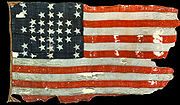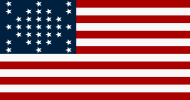
Fort Sumter Flag
Encyclopedia


Flags of the United States
-Historical progression of designs:Since 1818, a star for each new state has been added to the flag on the Fourth of July immediately following each state's admission...
with a distinctive, diamond
Diamond
In mineralogy, diamond is an allotrope of carbon, where the carbon atoms are arranged in a variation of the face-centered cubic crystal structure called a diamond lattice. Diamond is less stable than graphite, but the conversion rate from diamond to graphite is negligible at ambient conditions...
-shaped pattern of 33 stars. The flag was lowered by Major Robert Anderson
Major Robert Anderson
Robert Anderson was an American military leader. He served as a Union Army officer in the American Civil War, known for his command of Fort Sumter at the start of the war. He is often referred to as Major Robert Anderson, referring to his rank at Fort Sumter...
on April 14, 1861 when he surrendered
Surrender (military)
Surrender is when soldiers, nations or other combatants stop fighting and eventually become prisoners of war, either as individuals or when ordered to by their officers. A white flag is a common symbol of surrender, as is the gesture of raising one's hands empty and open above one's head.When the...
Fort Sumter
Fort Sumter
Fort Sumter is a Third System masonry coastal fortification located in Charleston Harbor, South Carolina. The fort is best known as the site upon which the shots initiating the American Civil War were fired, at the Battle of Fort Sumter.- Construction :...
, in the harbor of Charleston, South Carolina
Charleston, South Carolina
Charleston is the second largest city in the U.S. state of South Carolina. It was made the county seat of Charleston County in 1901 when Charleston County was founded. The city's original name was Charles Towne in 1670, and it moved to its present location from a location on the west bank of the...
, at the outset of the American Civil War
American Civil War
The American Civil War was a civil war fought in the United States of America. In response to the election of Abraham Lincoln as President of the United States, 11 southern slave states declared their secession from the United States and formed the Confederate States of America ; the other 25...
.
Anderson brought the flag to New York City
New York City
New York is the most populous city in the United States and the center of the New York Metropolitan Area, one of the most populous metropolitan areas in the world. New York exerts a significant impact upon global commerce, finance, media, art, fashion, research, technology, education, and...
for an April 20, 1861 patriotic rally, where it was flown from the equestrian statue of George Washington
George Washington
George Washington was the dominant military and political leader of the new United States of America from 1775 to 1799. He led the American victory over Great Britain in the American Revolutionary War as commander-in-chief of the Continental Army from 1775 to 1783, and presided over the writing of...
. More than 100,000 people thronged Manhattan's Union Square
Union Square (New York City)
Union Square is a public square in the Manhattan borough of New York City, New York.It is an important and historic intersection, located where Broadway and the former Bowery Road – now Fourth Avenue – came together in the early 19th century; its name celebrates neither the...
in what was, by some accounts, the largest public gathering in the country up to that time. The flag was then taken from town to town, city to city throughout the North, where it was frequently "auctioned" to raise funds for the war effort. Any patriotic citizen who won the flag at auction was expected to immediately donate it back to the nation, and it would promptly be taken to the next rally to repeat its fundraising magic. The flag was a widely-known patriotic symbol for the North during the war.
On April 14, 1865, four years to the day after the surrender and as part of a celebration of the Union victory, Anderson (by then a major general
Major General
Major general or major-general is a military rank used in many countries. It is derived from the older rank of sergeant major general. A major general is a high-ranking officer, normally subordinate to the rank of lieutenant general and senior to the ranks of brigadier and brigadier general...
), raised the flag in triumph over the battered remains of the fort.
The Rev. Henry Ward Beecher
Henry Ward Beecher
Henry Ward Beecher was a prominent Congregationalist clergyman, social reformer, abolitionist, and speaker in the mid to late 19th century...
was the principal orator at the 1865 celebration, and gave a lengthy speech, as was the custom of the day. He said:
Coincidentally, later that night President Lincoln
Abraham Lincoln
Abraham Lincoln was the 16th President of the United States, serving from March 1861 until his assassination in April 1865. He successfully led his country through a great constitutional, military and moral crisis – the American Civil War – preserving the Union, while ending slavery, and...
would be shot at Ford's Theatre
Ford's Theatre
Ford's Theatre is a historic theater in Washington, D.C., used for various stage performances beginning in the 1860s. It is also the site of the assassination of U.S. President Abraham Lincoln on April 14, 1865...
.
The Fort Sumter Flag is still on display at National Park Service
National Park Service
The National Park Service is the U.S. federal agency that manages all national parks, many national monuments, and other conservation and historical properties with various title designations...
. Commercial replicas of the flag are widely available.

